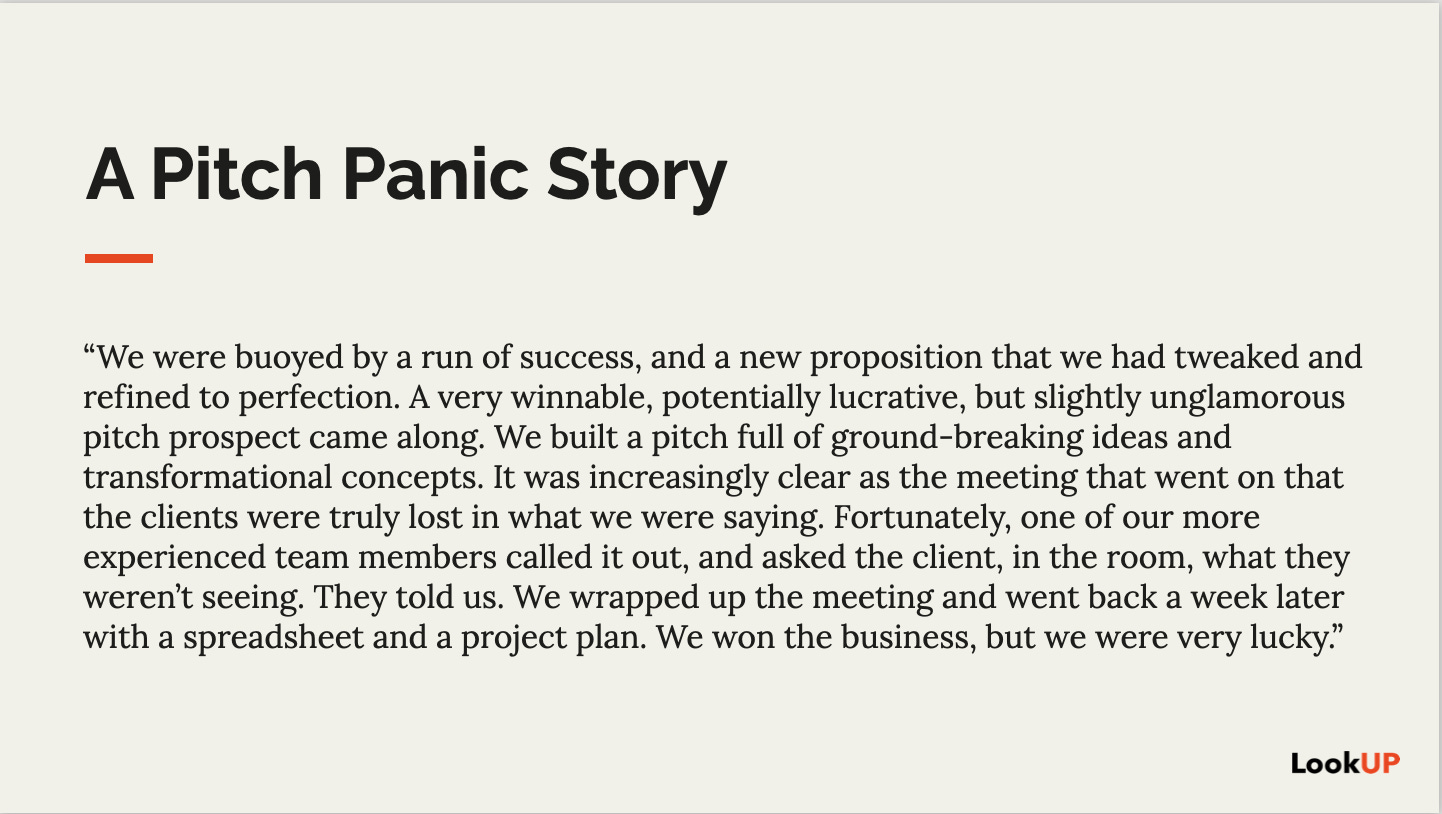Is it just me, or does it feel like we are all pitching, all the time?
In this pancake-flat economy, it takes more pitching to get what you want, whether that’s a new contract, a distribution deal, or investment to scale up.
In every pitch, there’s more abundant competition, in more different forms, and more power in the hands of aggregators and intermediaries as a result.
And every pitch has become more and more information rich - and therefore bloated with detail, stages and criteria.
Whether you’re a platform, an agency, a professional service, a media owner, or just an independent trying to get good work, pitch workloads are ever-escalating.
And we certainly don’t have more time and resource to get it all done.
The shadow of pitch frenzy is everywhere. And that means a lot of stress.
Pitch Panic is never far from the surface.
And it’s hurting.
People in marketing, media and advertising are struggling to reconcile their work with their mental health, and again and again it’s pitching which is straw that breaks the proverbial camel’s back. Industry bodies are rallying to support, but the pain is visible.
New business teams are looking in vain for hand-raisers, because pitching looks increasingly like a millstone around their necks, rather than an opportunity to grow.
That means relying on the usual suspects…and so businesses are failing to find to develop strategically, because their leaders are on a carousel of endless pitching.
So what’s the exit path?
Many can, and are, lobbying for systemic change to the process. We’d emphatically support initiatives like the Pitch Positive Pledge. But progress will be uneven, and slow.
As aspiring providers, suppliers, and investees, you need to control what you can.
Step one is to reduce your pitching activity. The best outcome of a pitch is to win it, the second best is to have never taken part. It’s easy to say, but hard to do - but it’s incumbent on decision-makers to only pitch where you really want to win, and can win.
Step two is to pitch better, and smarter. Because the truth is that whilst an immense share of our effort is going into pitching, a lot of pitches simply aren’t very good at making the impact they need to make.
In fact, if anything, the harder people are trying, the worse they are getting. Why?
At LookUP, we get to see this problem from every angle. We work as pitch narrative advisors, pitch team trainers, client advisors on pitches..and we pitch a lot ourselves.
Quantity or speed of pitch work is rarely directly proportional to success. In fact, often in where you see the highest levels of visible output, the pitching really isn’t working.
Because what you are seeing isn’t Pitch Winning. It’s Pitch Panic.
It’s a bubble of nervous energy, created by desperation to win, to leave no stone unturned, to avoid being seen as the person who dropped the ball.
Next week, we are going to give you a quickfire guide to pitch turnaround - how to get to the finish line with a chance of winning when Pitch Panic has already set in.
But to try and help you get ahead of it all, today, we are going to focus on 6 different types of bubbles of Pitch Panic - along with the tell-tale symptoms, the causes, and how to nip them in the bud.
Symptoms
This is one of the most commonly occurring Pitch Panic bubbles - when activity and production becomes the end, rather than the means. This can happen even on pitches where commitment is sky-high and resource is all in place.
It’s characterised by lot of different people focused on producing a lot of material without a clear idea of why they are doing it. Also evidenced by…
The proliferation of many sub-teams
Massive piles of paper and never-ending Teams shared documents (eurgh)
Long hours. Long nights. Angry designers. Painful burnout
Frameworks upon frameworks upon frameworks
End result - confused, impatient and irritable clients. A thank you, but no win.
Causes and interventions
This almost always starts at the top, when a pitch leadership team provides a sense of importance, but not direction. The lack of bandwidth, clarity or integration at the top generates work exponentially as soon as a larger team or a group of external partners gets involved.
And the greater the culture of fear, or even worse, self-preservation in the team, the greater the exponentiality of the pointless production, which becomes about internal demonstration, not winning externally.
The solve is a mixture of the practical and the emotional. Well thought-through StoryBoards and pitch one-pagers make a huge difference. A pitch culture of empathy and constructive challenge, set by leadership, should seal the deal.
Symptoms
This is particularly visible in political internal cultures, or nervous teams, where avoiding embarrassment takes primacy over maximising the odds of winning.
The symptoms are a consistent flow of decisions rooted in avoiding a negative, rather than landing a potential disruptive positive. For example…
Hedging: “we are this and we are that”
Impersonation of the competition, until you look almost the same
Adding imaginary credentials, tools and capabilities
Asking people to moderate their style, removing proposals with an element of risk
End result: coming second, or being told you came second, or claiming you came second, without ever hitting any real traction.
Causes and interventions
You see this trait most often where decision-makers feel on the back foot, either because of internal politics, or because of a sense of being out of their depth.
People focus intensely on qualifiers (credentials, performance) and walk away from anything unusual or high risk, thus massively reducing the chances of exciting a client. The end result can be a huge workload, as everyone works on ticking every box, other than the one that says ‘this is the partner I want’.
The solution is a combination of psychological safety, and having the strategic skills to devise a pitch that you know you can deliver well and authentically. The aim should always be to find a route to first choice, even if it just might put you last. At the worst, you gain respect, and the mercy of an early exit. Sometimes, you win.
Symptoms
This is a pitch bubble that’s hard to spot, because while you are in it, the pitch can actually feel quite good, and the team can be quite energised.
One of the first signs is that your pitch is laced with language and concepts about which you care deeply, but which aren’t really relevant to the task at hand.
These are the pitches which die in the final reviews, or in the room itself. Characterised by…
Many, many slides of in-depth credentials, without direct application
Materials that rest on aspiration, jargon, hyperbole
Failure to read the brief. Failure to understand what’s behind the brief. Failure to add your own substantiated insight to the brief
End result: a pitch that feels less potent the moment the actual decision-maker is in the room - and that they absolutely cannot explain when they leave it.
Causes and interventions
Even very good, very motivated teams can get into bubble thinking. In a world where businesses are endlessly reflecting on their purpose and positioning, and where contact with the end client can be quite fleeting, this is becoming more and more of a problem.
To defeat it, you need to hear from the outside world, and listen. Immerse in the other party’s world, their pressures, their stakeholders and customers. Get good pitch doctors and critical friends who are outside your bubble. Go outside, and kill your darlings.
As our LookUP Expert Mikael reminds us, sometimes winning or losing a pitch can be pretty simple…
“When at IKEA we were meeting agencies, we would always be mainly interested in two things. Not their fancy things, and fancy offices, but two crucial things. Did they really understand us, and our world, had they done their homework? And did they really understand the lives of the many people who we want as our customers? It sounds like a simple thing, but still, very rarely done.”
Mikael Ydholm, former Head of Global Media, IKEA
Symptoms
You may get a sense of this one if you notice that everyone is talking about ‘the pitch’, but actually meaning a single, final meeting, not the whole process. It’s a failure to take the whole journey as seriously as the destination.
You might spot it from that linguistic tell alone, but if not, you might see this if your pitch environment starts feeling like a movie lot, or backstage at a magic show…
People not wanting to share things until they are truly, completely ready
Lots of internal focus, but actual management of client interaction looks shaky
Long introductions that scatter breadcrumbs and don’t get to the point
Theatre in the place of a business case
Last-minute implosions of morale
End result: a decent enough presentation, but too little, too late. Occasionally, a massive wipeout, that could have been avoided with a little bit of testing.
Causes and interventions
This might not look like Pitch Panic, but it can be. It is revealing of an emotional state where the desire to absolutely nail the pitch leads to a kind of ‘dartitis’ - a reluctance to let your ideas make contact with the final recipient.
Pitches have a lot to learn from entertainment, but a pitch is generally a business case, wrapped in a story, delivered through an ongoing, multi-interaction experience.
The aim is not to save things for the day, but to constantly push one meeting, one question, one clue ahead. Show things that are unfinished, give options, push for rejection as well as enthusiasm. Make the ‘big day’ an affirmation, not a reveal.
Symptoms
Sometimes, Pitch Panic takes the form of a steady rollercoaster of dread, that disappears and re-emerges throughout. Something in the air that is never resolved.
This particularly emerges when people think you don’t have a chance of winning - but that’s a thing that people rarely want to say, so you have to look out for:
People under-delivering or drifting away
Important conversations going unresolved
Things being hidden or unresolved
Experts going unheeded
Last minute crises of confidence
End result: eventually, a client asks you the question you didn’t want to be asked. It begins to unwind your chemistry, and your offer. You put in 120% of the effort, and get 0% of the reward.
Causes and interventions
Most often, this is about denial. There is a fundamental reason why you are not in with a good chance - because you are an incumbent with a dodgy track record, your chemistry is shot to pieces, your team is too small / too big / lacks the capability.
Denial could be intentional, but more often in truth it is simple about a reservation that gets drowning in collective wishful thinking.
But you cannot ignore an elephant in the room. For one thing, it creates a high level of risk that all the work you are doing is going to be wasted. And, in fact, it’s worse than that - teams will work even harder to distract, to compensate, because they know the elephant is still there.
Right at the start of the process, you always need to ‘get your elephants on the table’. This might require an outside perspective to remind you where they are, and just how big they are. Then you can either ride the elephant with pride, making your flaw an asset, or mitigate it with conspiracy. It must, must, be proactively acknowledged. And in fact, the power to acknowledge your flaw, and your understanding of it, is an asset that no-one else can use.
A Final Word
Pitching can be game-changing, but it can also claim a lot of time and energy.
If you are a person who runs pitches, reviews pitches, leads pitches, participates in pitches or pitches solo, it’s important to know the telltale signs of Pitch Panic.
Do everything you can to stop them from emerging, and when they do, look them in the eye and do something differently.
Next week, we are going to share a short guide with some practical tips on how to rescue a pitch once the Panic has already taken root.
Until then…go well…and DON’T PANIC!
Three ways LookUP can help you to pitch better, and panic less…
Grow your squad of StoryTellers. We are currently building training programmes with partners from agencies, media and technology platforms, services firm and professional networks to build the foundations of excellent Pitch StoryTelling. Participants rate these at 9 out of 10 or more.
Bring us in for some Story Surgery. If you have a must-win pitch incoming, or your pitch is lost in a bubble of Pitch Panic, we can help you. We run rapid sprints, bringing in relevant experts if necessary, that give you an external perspective and help to get your pitch back on your feet. At speed.
Support your current and future stars. We run mentoring sessions which enable us to work with crucial pitching talent to find their core strengths and build on them, so they become consistent pitching superstars.
If you think any of these might be relevant for you, get in touch via stayahead@wearelookup.com.


















